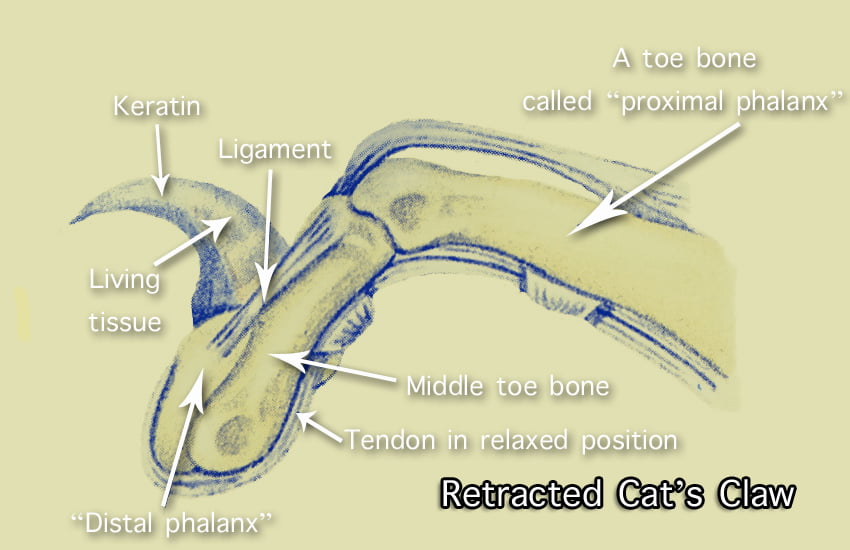This is a page on the anatomy of a cat’s claw written for children or people who like plain English. A few of the words are from the science of biology.

“Nails” are what some animal doctors (vets) call the claws of a cat.
This makes claws sound as if they are like the nails of a person.
It is wrong to do this because claws are different to nails, except for one thing. A person’s nails and the hard bit of a cat’s claws are made of the same stuff. It is called “keratin”, which is not a living substance.
There is also a softer, living, bit in the middle of a cat’s claw that is called “live dermis”.
Did you know that the spiky bits on a cat’s tongue, which are called “papillae”, are made of keratin too?
Cat claws do much more than human nails
The nails of a person don’t do much but the claws of a cat do a lot. They are very important to a cat. These are the things claws are used for:
- They are important in defending a cat from other cats and animals that might attack her and harm her.
- They help to grab things.
- A cat’s claws are part of a cat’s toes. As a cat walks on her toes (digitigrade), claws help with movement and running. The claws are an integral part of the highly refined feline anatomy which has been created through evolution over millions of years.
- They are used to scratch surfaces, which is a way for a cat to tell other cats that this is her place.
- A cat’s claw also helps a cat to stretch. When a cat uses a scratching post she may grab it and stretch her back as well as scratch it. If you buy a scratching post get a big, heavy one as your cat will like it much more. Scratching a post also helps remove the outer layer of the claw, making it new again.
- You’ll also see a cat scratching herself, sometimes. This helps to remove unwanted objects in her fur and to get rid of an itch.
- Claws help a cat to climb up and down trees and other things.
- When a cat jumps up her claws grab the place she is jumping to. This makes the jump safer and it helps her to jump further and higher.
 Claws grow from the last bone of the cat’s toes
Claws grow from the last bone of the cat’s toes
A person’s nail is attached to the skin of the finger. A cat’s claw grows out of the last bone of the cat’s toe. This is important. The cat’s claw is completely fixed to the toe. It is part of the bone of the toe and cannot be removed. It has to be firmly fixed like this because it is used so much and pulled so much. It has to be very strong.
Cat claws are hidden when not used
When a cat is not using her claws they are “retracted”. This means that the claw is pulled into the cat’s toe by a muscle and a tendon so you can hardly see it. This is the normal position for the claw. A “tendon” is tough stuff that connects muscle to bone.
Some wild cats don’t retract their claws so much because they need them out a lot to get a grip on the ground for fast running. The cheetah does this.
Claws get worn down
As a cat walks on his toes, claws gets worn down when used, such as walking on rough tracks and so on. Indoor cats don’t usually get a chance to wear down their claws so the cat’s owner should trim them. This is good for the cat and for the person.
Claws are good
If a person likes cats they should learn to like a cat’s claws because they are an important part of the cat and they affect how the cat behaves.
Click on the link for more on cat anatomy.
Note: I have lost the photographer’s name for the kitten. Sorry. Please come forward.
 Claws grow from the last bone of the cat’s toes
Claws grow from the last bone of the cat’s toes
Cat Fancy rocks!
Great and striking in its simplicity,well done Micheal.
To see that diagram of the claw explains it exactly as it is and vets axing off cats toe ends know full well they are cruel.
It has to stop.I’ll be sharing this article around too.
Thanks a lot Rose. I am a fan of plain English. That may surprise you coming from a retired solicitor 😉
Thank you for the Facebook Likes. It is very nice of you all. And thank Ruth for spreading the word. As I said, I believe the desired change in culture that accepts declawing as a routine operation is in the hands of kids. Perhaps some of the next generation will decide not to declaw their cats.